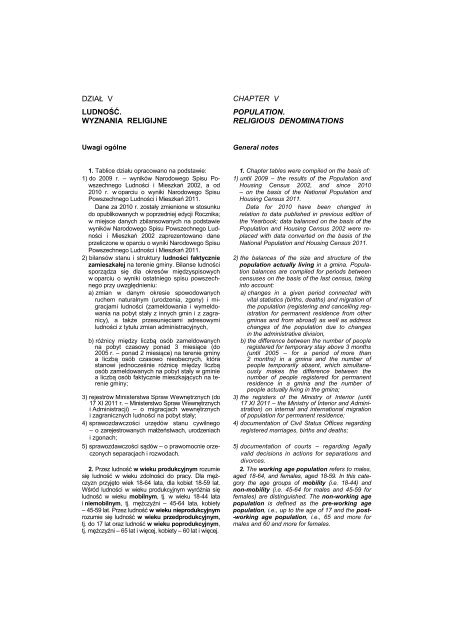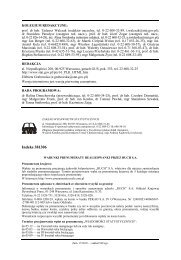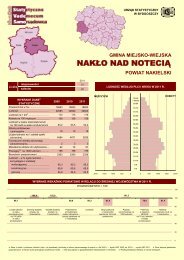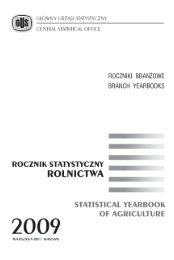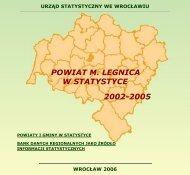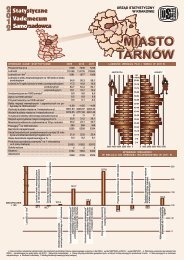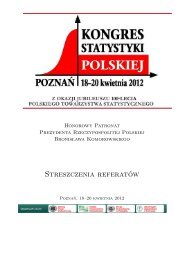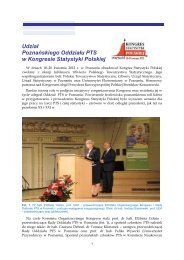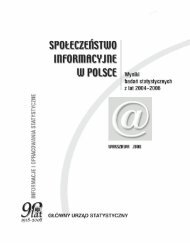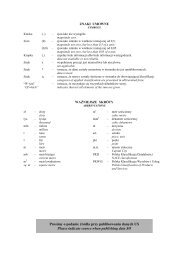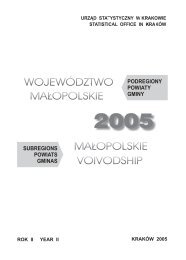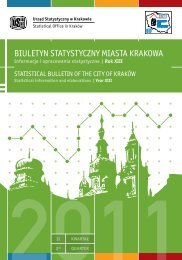Untitled - Główny Urząd Statystyczny
Untitled - Główny Urząd Statystyczny
Untitled - Główny Urząd Statystyczny
Create successful ePaper yourself
Turn your PDF publications into a flip-book with our unique Google optimized e-Paper software.
DZIAŁ V<br />
LUDNOŚĆ.<br />
WYZNANIA RELIGIJNE<br />
Uwagi ogólne<br />
CHAPTER V<br />
POPULATION.<br />
RELIGIOUS DENOMINATIONS<br />
General notes<br />
1. Tablice działu opracowano na podstawie: 1. Chapter tables were compiled on the basis of:<br />
1) do 2009 r. – wyników Narodowego Spisu Powszechnego<br />
Ludności i Mieszkań 2002, a od<br />
2010 r. w oparciu o wyniki Narodowego Spisu<br />
Powszechnego Ludności i Mieszkań 2011.<br />
Dane za 2010 r. zostały zmienione w stosunku<br />
do opublikowanych w poprzedniej edycji Rocznika;<br />
w miejsce danych zbilansowanych na podstawie<br />
wyników Narodowego Spisu Powszechnego Ludności<br />
i Mieszkań 2002 zaprezentowano dane<br />
przeliczone w oparciu o wyniki Narodowego Spisu<br />
Powszechnego Ludności i Mieszkań 2011.<br />
2) bilansów stanu i struktury ludności faktycznie<br />
zamieszkałej na terenie gminy. Bilanse ludności<br />
sporządza się dla okresów międzyspisowych<br />
w oparciu o wyniki ostatniego spisu powszechnego<br />
przy uwzględnieniu:<br />
a) zmian w danym okresie spowodowanych<br />
ruchem naturalnym (urodzenia, zgony) i migracjami<br />
ludności (zameldowania i wymeldowania<br />
na pobyt stały z innych gmin i z zagranicy),<br />
a także przesunięciami adresowymi<br />
ludności z tytułu zmian administracyjnych,<br />
b) różnicy między liczbą osób zameldowanych<br />
na pobyt czasowy ponad 3 miesiące (do<br />
2005 r. – ponad 2 miesiące) na terenie gminy<br />
a liczbą osób czasowo nieobecnych, która<br />
stanowi jednocześnie różnicę między liczbą<br />
osób zameldowanych na pobyt stały w gminie<br />
a liczbą osób faktycznie mieszkających na terenie<br />
gminy;<br />
3) rejestrów Ministerstwa Spraw Wewnętrznych (do<br />
17 XI 2011 r. – Ministerstwo Spraw Wewnętrznych<br />
i Administracji) – o migracjach wewnętrznych<br />
i zagranicznych ludności na pobyt stały;<br />
4) sprawozdawczości urzędów stanu cywilnego<br />
– o zarejestrowanych małżeństwach, urodzeniach<br />
i zgonach;<br />
5) sprawozdawczości sądów – o prawomocnie orzeczonych<br />
separacjach i rozwodach.<br />
2. Przez ludność w wieku produkcyjnym rozumie<br />
się ludność w wieku zdolności do pracy. Dla mężczyzn<br />
przyjęto wiek 18-64 lata, dla kobiet 18-59 lat.<br />
Wśród ludności w wieku produkcyjnym wyróżnia się<br />
ludność w wieku mobilnym, tj. w wieku 18-44 lata<br />
i niemobilnym, tj. mężczyźni – 45-64 lata, kobiety<br />
– 45-59 lat. Przez ludność w wieku nieprodukcyjnym<br />
rozumie się ludność w wieku przedprodukcyjnym,<br />
tj. do 17 lat oraz ludność w wieku poprodukcyjnym,<br />
tj. mężczyźni – 65 lat i więcej, kobiety – 60 lat i więcej.<br />
1) until 2009 – the results of the Population and<br />
Housing Census 2002, and since 2010<br />
– on the basis of the National Population and<br />
Housing Census 2011.<br />
Data for 2010 have been changed in<br />
relation to data published in previous edition of<br />
the Yearbook; data balanced on the basis of the<br />
Population and Housing Census 2002 were replaced<br />
with data converted on the basis of the<br />
National Population and Housing Census 2011.<br />
2) the balances of the size and structure of the<br />
population actually living in a gmina. Population<br />
balances are compiled for periods between<br />
censuses on the basis of the last census, taking<br />
into account:<br />
a) changes in a given period connected with<br />
vital statistics (births, deaths) and migration of<br />
the population (registering and cancelling registration<br />
for permanent residence from other<br />
gminas and from abroad) as well as address<br />
changes of the population due to changes<br />
in the administrative division,<br />
b) the difference between the number of people<br />
registered for temporary stay above 3 months<br />
(until 2005 – for a period of more than<br />
2 months) in a gmina and the number of<br />
people temporarily absent, which simultaneously<br />
makes the difference between the<br />
number of people registered for permanent<br />
residence in a gmina and the number of<br />
people actually living in the gmina;<br />
3) the registers of the Ministry of Interior (until<br />
17 XI 2011 – the Ministry of Interior and Administration)<br />
on internal and international migration<br />
of population for permanent residence;<br />
4) documentation of Civil Status Offices regarding<br />
registered marriages, births and deaths;<br />
5) documentation of courts – regarding legally<br />
valid decisions in actions for separations and<br />
divorces.<br />
2. The working age population refers to males,<br />
aged 18-64, and females, aged 18-59. In this category<br />
the age groups of mobility (i.e. 18-44) and<br />
non-mobility (i.e. 45-64 for males and 45-59 for<br />
females) are distinguished. The non-working age<br />
population is defined as the pre-working age<br />
population, i.e., up to the age of 17 and the post-<br />
-working age population, i.e., 65 and more for<br />
males and 60 and more for females.


